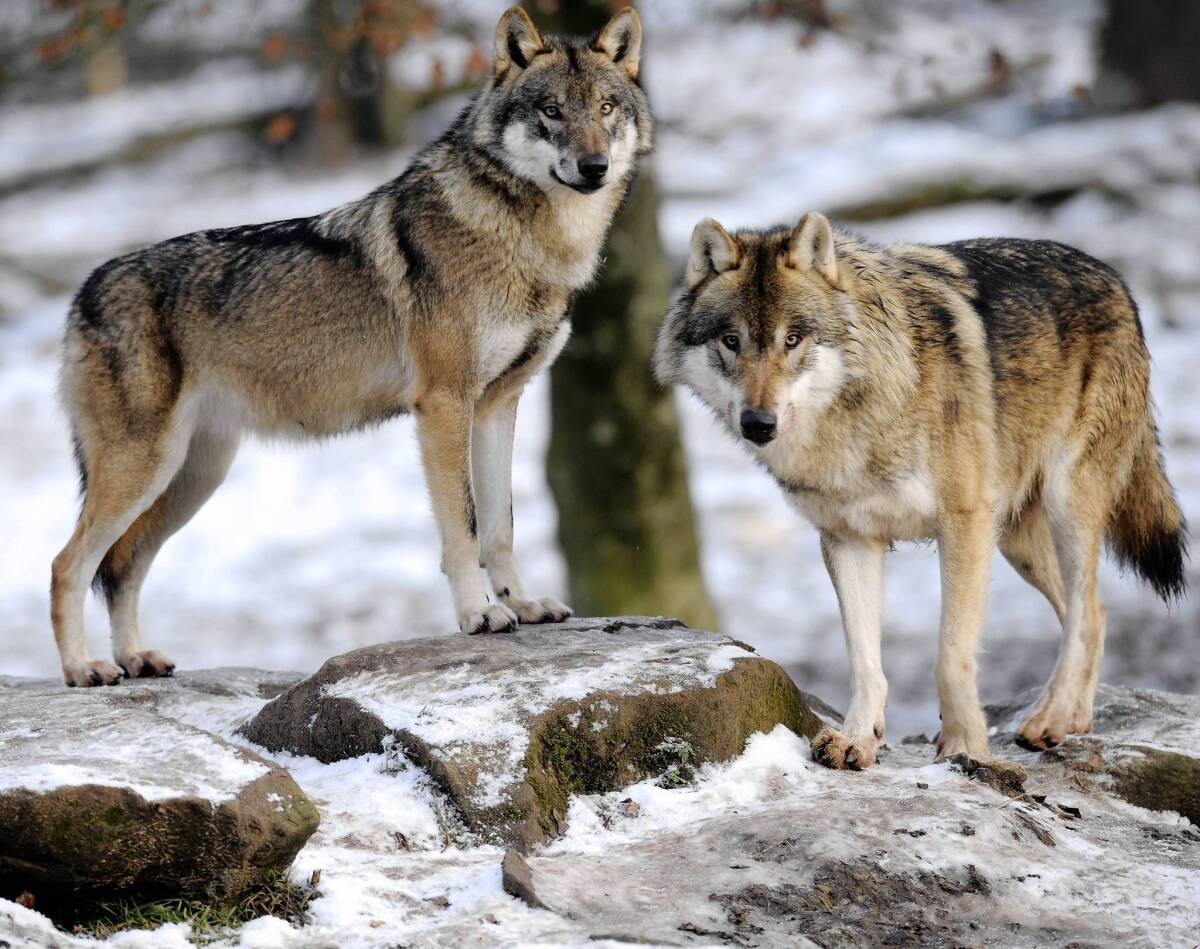Carbs were key in wolves’ evolution into dogs

- Share via
Long ago, some brazen wolves started hanging around human settlements, jump-starting events that ultimately led to today’s domesticated dogs. Now geneticists say they have identified one of the key changes that turned wolves into the tame, tail-wagging creatures well-suited to living by our sides — the ability to digest carbohydrates with ease.
The report, published online Wednesday by the journal Nature, found signs that dogs can break down starch into sugar, and then transport those sugars from the gut into the bloodstream, more efficiently than can wolves. Comparing dog and wolf DNA, the authors pinpointed several changes in starch and sugar-processing genes that would have made early dogs better able to digest the scraps they scavenged from dumps in early farming villages, helping them to thrive as they gave up the independent life of the pack to entwine their lives with ours.
“That food was obviously the same kind of food that we were eating,” most likely a mix of roots, porridge and possibly bread along with bones containing meat and marrow, said study leader Erik Axelsson, an evolutionary geneticist at Uppsala University in Sweden.
No one knows for sure when or where the first dogs came to be, but most evolutionary biologists agree that the wolf probably made the first move and that the draw was the food humans discarded. Only much later did people intensively mate dogs of different shapes and temperaments to create today’s hundreds of breeds and varieties, from the hulking and noble to the tiny and yapping.
The new analysis by Axelsson and his colleagues examined a mix of DNA from 12 gray wolves and compared it with DNA collected from 60 domestic dogs, including cocker spaniels, giant schnauzers, golden retrievers and 11 other breeds.
The scientists sequenced the dog and wolf DNA and searched for tiny differences. Because they were seeking features that cropped up early in dog evolution, they focused on genetic variations that dogs shared but wolves lacked. They also looked for variations that all, or most, of the dogs had in common.
From this analysis, the team identified 36 places in the genome, containing 122 genes, that seemed to have been important in dog evolution. Ten of the genes are involved in starch or fat metabolism, including three that carry instructions for making a protein that is pivotal to digestion of starch.
One of them makes alpha amylase, an enzyme that breaks starch into the sugar maltose and shorter carbohydrate strands. Dogs carry many more copies of this gene than wolves, the scientists found — and the alpha amylase activity in their tissues is five times greater.
Another gene makes an enzyme for the next step in carb digestion: turning maltose into glucose. This gene is 12 times more active in dogs than wolves, and blood tests showed that maltose is processed into glucose twice as quickly in dogs.
The third gene makes a protein that moves glucose from the gut into the bloodstream. The scientists saw several dog-specific alterations in this gene that suggest the glucose transporter may work more efficiently in dog guts than wolf guts.
Taken together, the data fit with the fact that dogs eat more starch than wolves, Axelsson said. He added that this adaptation would have allowed the first dogs to get more goodness out of the waste food they were drawn to at early farming settlements.
“It makes perfect sense that the most efficient scavengers were the wolves that could cope with this starch-rich diet,” he said.
Still, dog domestication may have happened long before humans adopted an agrarian life about 10,000 years ago, said Robert Wayne, an evolutionary biologist at UCLA who wasn’t involved in the Nature study.
Perhaps dogs evolved through hanging around hunter-gatherers so they could feed on leftover carcasses of the mammoths and mastodons our ancestors killed, Wayne said. In that scenario, the starch-tolerant changes would have cropped up only after dogs were domesticated, just as genetic changes that help break down starch evolved in human beings after we adopted a farming life.
Part of the reason why the timing of dog domestication is debated is that the fossil record is confusing. The oldest broadly agreed-upon dog fossil is 12,000 years old, of a pup buried with its human in modern-day Israel. More recently, scientists have discovered far older dog-like fossils, including one in Siberia that dates back 33,000 years.
Those remains have skulls that are smaller than wolf skulls but teeth that are wolf-sized, and they are often found alongside specimens that were clearly wolves, said evolutionary biologist Susan Crockford of the University of Victoria in Canada. It will take more study of fossils and ancient DNA to sort out whether these were wolves that had started down the road toward domestication or were merely examples of the natural variation that existed in wolves, she said.
In addition to the starch genes, Axelsson’s team found others involved in brain and nervous system development that appear to have been important in the transition from wolf to dog.
That isn’t surprising, said Adam Boyko, an evolutionary geneticist at the College of Veterinary Medicine at Cornell University in Ithaca, N.Y., who wasn’t involved in the study. Dogs differ behaviorally from wolves in myriad ways, he said — in tameness, curiosity, social structure, tail-wagging, novelty-seeking behavior and their penchant to bark (and bark) well into adulthood.
The next step is to study that list of genes to figure out how they affect behavior and development to make dogs distinct, Boyko said.
Oscar Chavez, director of the veterinary technician program at Cal Poly Pomona, said the findings served as a reminder that dogs don’t eat like wolves. He said he and his colleagues were befuddled by the trend toward pricey low-carb dog foods and raw diets, which could stress dogs’ kidneys with their extra protein load.
“Dogs are dogs — they’re more reliant on starches and grains,” he said, which is why commercial dog foods are formulated to contain about 20% to 30% protein and 40% to 50% carbs. “I don’t know any veterinarian in my circle of colleagues that would recommend a low-grain diet.”





